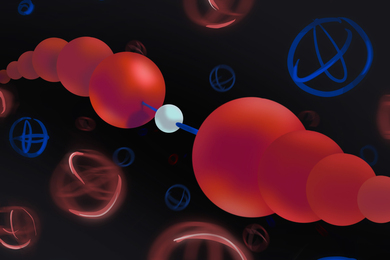MIT's excellence in brain research will be showcased next week in San Diego as Institute scientists give five of the 24 invited talks at the annual meeting of the Society for Neuroscience.
"This is an extremely high representation from one institution," said Mriganka Sur, chair of the Department of Brain and Cognitive Sciences and one of the MIT speakers.
The Society for Neuroscience is the world's largest organization of scientists devoted to studying the brain. Some 30,000 people are expected to attend the group's annual -conference.
One of the five MIT researchers, H. Sebastian Seung, professor of computational neuroscience, will give the Presidential Special Lecture on "The Once and Future Science of Neural Networks." In his talk, Seung will describe a revolutionary new way to create a nanoscale-level map of the brain's axon and dendrite "wires" based on actual human brain tissue. This cutting-edge field, called computational neuroanatomy, is expected to confirm or deny long-held basic assumptions about how the brain works.
Seung's laboratory is one of a handful in the world working on a new initiative called "the connectome," which seeks to translate three-dimensional images of the brain at nanoscale resolution into a circuit diagram of all the brain's neurons and synaptic connections.
Current models of the human brain revolve around the belief that synapses' connections determine brain function and that synaptic plasticity underlies learning and memory. But now, "we have seen tantalizing hints that these basic ideas are at least partially true, as well as examples where they fall short," said Seung, who also is a Howard Hughes Medical Institute (HHMI) investigator. "The advent of high-throughput methods for gathering neurophysiological and neuroanatomical data will transform our ability to test the foundations of neural network theory."
The other MIT speakers and their topics are:
Mark F. Bear, Picower Professor of Neuroscience, director of the Picower Institute for Learning and Memory and HHMI investigator, will speak on "Modification of Cerebral Cortex by Experience." More than four decades of research on how synapses are formed, strengthened, weakened and lost under the influence of sensory experience have culminated in a deep understanding of the mechanisms for this synaptic plasticity. The knowledge ranges from novel insights into the pathophysiology of developmental disorders to new strategies to enhance perceptual learning and recovery from environmental deprivation, he said.
Li-Huei Tsai, Picower Professor of Neuroscience and HHMI investigator, will speak on "Mechanisms Underlying Prevention of Cognitive Decline and Restoration of Memory in Age-Dependent Neurodegenerative Disorders." The number of people with Alzheimer's disease is expected to triple from 5 to 15 million by the year 2050. Age-dependent neurodegeneration and dementia is currently incurable. Tsai's lecture will focus on recent research of cellular mechanisms, including synaptic plasticity, which have provided models for understanding neurodegeneration and memory loss. A particular emphasis will be placed on new strategies to prevent decline or restore memories.
Mriganka Sur, Sherman Fairchild Professor of Neuroscience, will speak on "New Approaches for Revealing Cortical Function: Plasticity and Dynamics of Visual Cortex Networks." Sur will talk about how a range of novel tools, including in vivo high-resolution imaging of neurons, synapses and astrocytes, cell-specific markers and genetically engineered probes, along with new experimental paradigms, are transforming the analysis of cortical networks.
Susan L. Lindquist, professor of biology, member of the Whitehead Institute for Biomedical Research and HHMI investigator, will give the Albert and Ellen Grass Lecture. Proteins begin as long strings that must fold precisely. The misfolding of certain amyloidogenic proteins associated with neuronal cells is responsible for certain neurodegenerative diseases. Surprisingly, she said, similar changes in the folding of other proteins may have beneficial effects in learning and memory. Lindquist's lecture will investigate therapeutic strategies to control the folding of amyloidogenic proteins.
A version of this article appeared in MIT Tech Talk on October 31, 2007 (download PDF).





